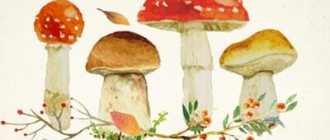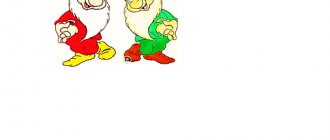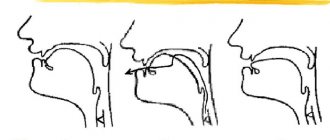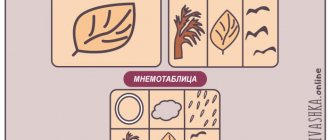Recommendations for conducting classes
If you want to use pictures of mushrooms for activities with children, then you should consider several rules for their use:
- Give your child the opportunity to take a good look and study new images in each drawing, and only then use them for educational exercises or games.
- Pay attention to the quality of the pictures. It is best to use special speech therapy illustration sets produced for kindergarten, but you can also take realistic images from the Internet or use photographs.
- Be sure to select a variety of handouts - both subject pictures and plot ones. The first are small cards with single images of mushrooms, and the second are illustrations of a real (hedgehog with mushrooms) or fairy-tale (series of pictures Under a mushroom) situation on the topic. For the development of speech in preschoolers, both types of visual material are necessary.
- Any illustration for classes must be made in a realistic manner, accurately repeating all the elements of the external structure of a particular object.
- It is most convenient to use cards with names that older preschoolers can read themselves.
- Images of mushrooms on a transparent background significantly expand the possibilities of using them when composing stories.
Cards by Glen Doman on the topic “Mushrooms”:
Games
Different pictures of mushrooms for children allow you to conduct many different kinds of speech therapy games. Here are some examples:
- Collecting mushrooms
Each player chooses one picture of a mushroom and tries to describe its external features. If the other player guesses right, the card goes to him. The one who collects the most pictures wins.
- How are we similar?
An adult chooses two cards (boletus-boletus, white-boletus, russula-fly agaric) and invites the children to see as many differences between them as possible. The last one to answer wins.
- Cheerful cooks
Invite the children to “cook” a lunch of different edible mushrooms that they know. Everyone must choose one picture and name a dish that can be prepared with one or another mushroom (for example: porcini mushroom soup, pickled boletus, boletus mushrooms in sour cream, salted milk mushrooms, etc.
- Oh, what a honey fungus we have!
The image of any mushroom is transmitted from one player to another. Everyone names one of its characteristics, distinctive features of the external structure. The winner is the participant who can see and name some detail last.
- Tales from storytellers
Ask each player to choose one specially selected picture of a mushroom for children. Then everyone must come up with a short story about their character. Tell about his character, habits, activities. For example, Borovik is the king of all mushrooms in the forest, he is strict and important, busy with government affairs from morning to evening, loves to play football and play the balalaika. Older preschoolers can be asked to come up (in a circle) with a whole story about the mushroom kingdom; everyone can draw illustrations for the fairy tale together.
- Mosaic: find a piece
Make cut-out pictures from the cards and invite your child to assemble them. You can use drawings of poisonous and edible mushrooms for this game.
- Full basket
Invite your child to select several cards (he will need a small basket for this), memorize them well and repeat all the names by heart without looking into the basket again. Each player can try to become a mushroom picker by collecting their own set of cards.
Demonstration material on the topic “Mushrooms” card index on the world around us (middle group) on the topic
Yellow chanterelle
It's good to collect chanterelles. After warm rains, they come out in whole families and never hide from the mushroom picker, showing off in the clearing like reflections of the sun or egg yolks.
Chanterelles differ from all other mushrooms primarily in the elegant shape of their fruiting bodies. The delicate yellow folds of the plates fancifully branch out all the way to the ground along a tapering stem; the edges of the bright, clean caps seem corrugated. Everyone who finds chanterelles in the forest notes their beauty; it is even a pity to hide this living “omelet” in the basket. Very small chanterelles look like yellow buttons, while larger mushrooms surprise with their bizarre shapes.
Mushroom pickers consider chanterelles to be special mushrooms. Of all the diversity of the mushroom kingdom, they are the only ones that are not spoiled by mushroom flies. In addition, chanterelles do not break, so you can carry them in backpacks, bags, and sacks and not be afraid that you will only bring crumbs and debris home. Chanterelles rightfully deserve the respect of housewives. They are good in stir-fries, soups, and sauces. In terms of vitamin A content, chanterelles can be compared with boletus and saffron milk caps, and they contain even more vitamin B than yeast. These mushrooms are high in calories and are easily absorbed by the body. Chanterelles have another advantage: they contain large quantities of so-called ergosterol, a natural antibiotic.
Death cap
Sometimes, next to forest champignons, you can see their poisonous counterpart - the toadstool. This is a terrible mushroom: a small piece of it, dropped into a soup or roast, can cause severe, sometimes even fatal, poisoning. Therefore, when picking mushrooms, you need to be extremely careful not to put poisonous toadstools in the basket along with good mushrooms.
Pale toadstool is sometimes called false champignon, since these mushrooms are very similar to each other, especially in the first stage of growth. A mature mushroom is much easier to distinguish: its cap, unlike the champignon cap, is surrounded by a fringe that hangs sluggishly towards the stem; Wart-like protuberances appear on the entire surface of the mushroom.
Distinctive features of the toadstool are also white plates (in the champignon they are pink or purple) and a white cover at the base of the leg. However, the signs by which the pale toadstool can be distinguished from the champignon, as luck would have it, are found in another mushroom - the pusher-floater, which has the same cover and a sac-like vagina at the base of the stem. The pale grebe can be identified only by the ring on the leg, which the pusher does not have.
The toadstool is considered the most poisonous mushroom in the world. Several toxic substances were found in its pulp: phalloidin, amanitins, falloin and others. 100 g of fresh mushroom contains 10 g of phalloidin, while a lethal dose of this substance is considered to be 2-3 mg. In the northern regions, the pale toadstool does not grow: there it is replaced by the white toadstool (smelly fly agaric). As the name suggests, this mushroom has an unpleasant odor, which becomes even stronger in mature mushrooms. Poisonous white toadstool is a fairly large mushroom. The cap can reach a diameter of 12 cm, it is white, with a slight yellowish tint in the center. When young, the cap of the white grebe is bell-shaped, but later becomes prostrate, although it never opens completely. The toadstool's leg, also white, is decorated with a ring located almost under the cap itself. The mushroom cap is smooth, while large scales are noticeable on the stem, which make it rough. Pale grebe grows in deciduous or mixed forests, usually associated with oak, hornbeam, birch and beech. In addition, the fungus readily forms mycorrhiza with linden or maple.
An important condition for the spread and activity of vegetation is soil moisture. The grebe prefers to grow in those areas of central Russia where a lot of precipitation falls and lingers. It often inhabits sphagnum-type pine forests. The fly agaric, unlike the toadstool, is not so picky about soil and weather conditions. It grows well even in dry years.
Toadstool is also a deadly poisonous mushroom, so be careful not to put it in your basket with edible mushrooms. The pulp of the white toadstool, along with other toxins, contains virosine, which causes fatal poisoning. If you eat these mushrooms in a proportion of 2 mg per 1 kg of weight, death occurs within 48 hours.
Toxins contained in white toadstool affect the liver, intestines, and other internal organs. The most toxins are contained in the cap and volva of the mushroom, slightly less in the plates and stem of the fruiting body.
Porcini
Porcini mushroom is the dream of any mushroom picker. This is the most valuable of the cap mushrooms in nutritional terms. In Russia, there are several forms of porcini mushroom, which are distinguished depending on the place of growth. The cap of porcini mushrooms is pillow-shaped and round, the stem first looks like a tuber, and then stretches out. It is thicker at the bottom than at the top, and sometimes has a thickening in the middle. The bottom of the cap is white, turns yellow with age, the flesh of the mushroom is white, does not change color when broken. The mushroom has a pronounced pleasant smell.
Porcini mushrooms come in a variety of sizes. On average, the height of the stem reaches 7-12 cm, its diameter can be within 2-6 cm. The size of the mushroom depends on weather conditions. After a good rain, you can find many larger porcini mushrooms in the forest. There are mushrooms that weigh from 1 to 1.5 kg. But this is not the limit: there is a known case when a white mushroom weighed 6 kg!
The porcini mushroom should not be confused with the similar gall mushroom. Here are their main differences from each other: the gall mushroom turns a little pink at the break, while the white mushroom retains its color. The tubular layer of the gall fungus becomes pale pink with age. The tubular layer of the porcini mushroom turns yellow with age. Finally, the taste of the gall mushroom is very bitter, while the taste of the white mushroom is pleasant.
The birch form of the white mushroom grows in birch forests. This mushroom is light in color: the cap is whitish, yellowish or brownish, the leg is white, with a mesh pattern, it can be slightly colored, but is always lighter than the cap. Porcini mushrooms are found throughout the summer and in the fall until the cold weather. All kinds of dishes are prepared from them and stored for the winter. When dried, the pulp of the porcini mushroom remains white, the smell changes somewhat, but still remains pleasant.
The spruce porcini mushroom differs from other types of porcini mushroom in that its cap is dark in color: it can be brown or brown, often alternating darker and lighter areas.
The leg is white or brownish, about a third covered with a pronounced mesh. You can find spruce porcini mushroom in spruce and fir forests in the north of the European part of Russia, as well as in the Caucasus. It grows from June to October. Has a pleasant smell.
The porcini mushroom gets along with almost all tree species. It even grows in the tundra, next to dwarf birch. However, scientists have noticed that the porcini mushroom never grows with larch, despite the fact that it is quite widespread in Russia.
In general, white is one of the most typical edible agaric mushrooms of the temperate zone of Russia and other countries. Probably, it was precisely because of its ubiquity and excellent taste that until the 16th century, only boletus was called a mushroom in Rus'. Ryzhiki, russula and others were simply called “mushrooms”, confirmation of which is not difficult to find in Domostroy and other books of that time. The modern name appeared much later, approximately simultaneously with the word “boletus.” Then mushroom pickers, and after them botanists, learned to distinguish between the spruce and pine forms of the porcini mushroom.
Already in the 15th century, people dried porcini mushrooms, put them in pies, and used other methods of preparing them. Today, boletus attracts the attention of not only cooks and mushroom pickers, but also doctors. Scientists have discovered that it contains biologically active substances that have bacteriostatic and antiblastic effects. The former reduce the number of E. coli and a number of other pathogenic microorganisms. The latter have a positive effect on the condition of cancer patients
Volnushka pink
Pink moth is a very common mushroom that grows in birch and birch-mixed forests. It usually grows in groups, so when you find one mushroom, you should look nearby for other mushrooms, and maybe a whole family. The pink volnushka is larger than its relative, the white volnushka. Its cap is usually from 4 to 12 cm in diameter, flat, fluffy, with a small funnel in the center, red-pink, with pronounced zones of these shades. The edges are strongly turned outward. The leg is 4-9 cm long, fluffy, and becomes naked with age. Most often, the stem is the same color as the cap, but a little lighter.
The flesh of the mushroom is brittle, white or creamy. The mushroom contains a sharp and bitter-tasting milky juice that does not change color in air. On the underside of the cap there are whitish or yellowish-pink frequent plates. Pink volnushka is edible and is considered a mushroom of the second category. It is collected and salted by mushroom pickers; in addition, salted pink volnushka can be bought in the store. Pink trumpet is not poisonous, but very bitter and tasteless when fresh. These mushrooms are eaten only salted or pickled 40-50 days after pickling, when the bitterness disappears.
Writer Oleg Chistovsky in his book “Familiar Strangers” describes a case when a group of scientists exploring the Eastern Sayan Mountains was unfortunately left without food supplies. There were no animals in the cedar forests through which the researchers moved, and hunting was excluded. Then the scientists began to eat boiled mushrooms. And although it was not a very suitable food (boiled trumpet is unacceptable for the stomach), the scientists survived only thanks to mushrooms.
The closest relative of the pink wave is the white wave. The cap of the white moth is white or cream-colored, pinkish in the middle, 4-8 cm in diameter, fluffy, depressed in the middle. The edges of the cap are curved outward and fluffy. The leg is short, 2-4 cm long and 1.5-2 cm tall, white or pinkish, fluffy or glabrous.
The flesh of the mushroom is white or pinkish and smells pleasant. The mushroom contains a white milky juice that does not change color in air. The underside of the cap is covered with frequent narrow light fawn, white or pinkish plates.
White trumpet grows in deciduous and mixed forests, loves the vicinity of birch, and is found in a meadow near the forest, as well as in young birch forests. Its season begins at the end of summer and lasts until October. It is less common than pink trumpet. White trumpet is edible. It is considered a second category mushroom, although few mushroom pickers like to collect it. Some scientists consider it not edible at all. They eat it only salted, and many days after salting.
Volnushka belongs to the Russula family. Indeed, in appearance it is somewhat reminiscent of russula. However, the main difference between russula and volushka is the absence of white juice, which is released when the mushroom is broken. Based on this feature, two types of mushrooms are generally distinguished - russula and laticifers, to which the trumpet belongs.
It differs from other milkweeds, and primarily from the white butterfly, in the shape and color of its cap, as well as its hollow stalk, which is covered with fluff in young fruiting bodies. Experienced mushroom pickers believe that after the massive appearance of volzhanka, popularly called volzhanka, or krasul, the time has come for the “real”, that is, September, milk mushrooms.
Real milk mushroom
The real milk mushroom appears in the fall, when the foliage fades, the grass becomes variegated, and there are long rains every day. To find milk mushrooms you need special skill: you should look closely at all the hummocks and tubercles on the ground, since only the swollen leaf litter tells you where the family of mushrooms is located.
A mushroom found under rotten leaves seems like perfection. His milky white hat, like marble, sparkles in his hands like mother of pearl. Other types of milk mushrooms also have white caps, but none of them ever have a cap as pure white as a true milk mushroom. In terms of whiteness of clothes, neither the noble boletus nor the russula can compare with milk mushrooms.
The fluffy fringe along the edges of the cap also adds elegance to the mushroom; by this feature it is easy to distinguish a real milk mushroom from its counterparts: the violin milk mushroom, the pepper milk mushroom, and the white milk mushroom.
Milk mushrooms have long been famous as the most famous mushrooms in Russian cuisine. Previously, Russia served as the main supplier of milk mushrooms to European countries. The best, highest grade are small, strong milk caps (cap size no more than 2.5 cm). Miniature salted milk mushrooms in bottles were sent to Europe. In Paris, for example, they were considered a delicacy. Salted milk mushrooms of the first grade had a cap size of up to 5 cm, and the second grade were mushrooms whose caps reached 9 cm in diameter.
Oiler grainy
Butterfly is one of the most delicious mushrooms. True, there is a lot of hassle with it: each fungus must be peeled and only then cooked according to taste and mood. The name was given to the mushroom for a reason: it is slippery and oily to the touch, and the skin is covered with mucus.
No amount of trouble stops mushroom pickers, who rush into the forest in the hope of picking up a basket full of butter. By the way, this is not difficult to do even for a completely inexperienced assembler. Butterflies are a surprisingly friendly “people”: where there is one fungus, there are a dozen more. Long strings of mushrooms hide in the grass, under fallen needles. You just have to guess and be in time by the time when the mushrooms are all small, strong, one to one; Otherwise, the mushroom picker will be disappointed: sometimes he cuts off one oil can after another, but the mushrooms are all overgrown and wormy, so that out of a dozen only one will end up in the basket.
The grainy oiler is very similar to the real one, but does not have a filmy ring on the stem. In addition, a grainy oiler is less slippery because it has less sticky mucus on the cap. The granular oiler is named because of the small warts or grains present on the upper part of its stem. Unlike the real one, the granular oiler prefers pine forests of southern areas, where it grows in exceptional abundance and is found much more often than the real one.
Red fly agaric
The red fly agaric is a hallucinogenic mushroom. Its pulp contains choline and the alkaloid muscarine, as well as substances that have a stimulating effect on the nervous system. The hallucinogenic properties of the mushroom have been known since ancient times.
In India and South America, the red fly agaric was widely used in ritual ceremonies. Since ancient times, the peoples of the Far North were aware of these properties of the fly agaric and considered them to be sent from above. There were even ceremonies of worship of the “divine mushroom”; During this ritual, each participant ate a piece of red fly agaric, falling into a state of ecstasy. Hallucinations caused by the mushroom were interpreted as messages from heaven.
The peoples of the Far North and Siberia widely used this mushroom, replacing alcoholic beverages with fly agaric infusions and decoctions. Travelers who visited Siberia in the 17th century were surprised to see how, after tasting a decoction of dried, purple mushroom caps with white warts, local residents fell into a state similar to alcoholic intoxication. Often it turned into a deep sleep, accompanied by hallucinations.
Despite the fact that fly agaric is poisonous, it is widely used in medicine. Since ancient times, preparations from fly agaric have been used for various tumor diseases, tuberculosis, diseases of the nervous system, rheumatism and arthritis. Infusions of fresh red fly agaric were used to kill insects.
The red fly agaric is widespread on the European continent and North America. However, it has been experimentally proven that the most poisonous variety of the red fly agaric grows in Siberia. Amanita mushrooms in Japan and the USA can cause a state close to alcoholic intoxication, but only Siberian mushrooms can cause death due to the increased content of toxins in their pulp.
The red fly agaric usually forms fruiting bodies in July-August, but if the year is dry, mass fruiting shifts to a later date. Sometimes a handsome man in a red hat with white freckles can be seen even in October.
The fly agaric lives for 15 days. First, a white “egg” appears from the ground - a mushroom shrouded in a blanket. Then the spathe bursts, and only part of it remains on the cap in the form of flaky residues or warts. The fungal spores ripen immediately after the ring is separated from the cap. On the 2-3rd day after ripening they begin to bear fruit; sporulation continues for 4-5 days, after which the mushroom dries out.
If the year is rainy, then the white warts on the mushroom cap can be washed away by the rain, and the red fly agaric can easily be confused with russula. Therefore, special care should be taken when collecting mushrooms during the rainy season. The fly agaric differs from russula by the presence of free plates, a ring at the top and a roller at the bottom of the stem.
A related species of the red fly agaric is the royal fly agaric. It is distinguished primarily by its brownish cap color.
Numerous warts, located in concentric circles on the cap, may not have a pure white, but a gray-brown or ocher tint. The leg of the fly agaric, as well as the ring and tuber, are ocher in color; at the bottom of the tuber there are 3-4 circles of warts. The color of the mushroom pulp is white, but underneath the skin is a darker shade. This mushroom grows mainly in northern and middle latitudes.
Real honey fungus
Honey fungus (autumn) settles in large groups on rotten and living wood. This fungus is a dangerous parasite that infects more than two hundred species of higher plants with white rot. Fungal spores penetrate the wood through the smallest damage. Mycelium develops under the bark. Its dark brown, almost black cords - rhizomorphs - penetrate inside the tree and infect the cambial layer of cells located between the bark and wood. The tree actively resists infection and secretes protective substances, but they are unable to cope with the mycelium and only slow down the process of destruction. In addition, the mycelium of the honey fungus releases toxins that have a detrimental effect on the tree, hastening its death. The parasitic fungus is capable of destroying a young tree in 1 year, and an old tree in 10 years.
The real honey fungus also settles on rotten wood. In this case, the following can often be observed: stumps inhabited by honey mushrooms glow faintly in the dark with a non-flickering white phosphorescent light. The light is emitted not by rotten mushrooms, but by the ends of rhizomorphs - the cords of the mycelium.
Boletus.
Boletus (birch cap), like some other mushrooms, has an interesting feature: it is capable of growth and development only on birch roots. The fungus entwines the root from the outside and partially penetrates inside.
The fungus itself is not capable of synthesizing organic substances, so it receives carbon nutrition from the birch root. But it would be completely wrong to think that the boletus is a parasite that sucks nutrients from the root of a tree.
The mushroom is also useful for birch. Its outer free hyphae spread widely in the soil from the root, replacing root hairs. Free hyphae of the fungus receive water, mineral salts, and soluble organic substances from the soil, which are not only used by the fungus to build mycelium and fruiting bodies, but also enter the root of the tree.
The boletus is popularly called a black mushroom or black mushroom, since the mushroom turns black when dried.
The boletus grows in birch forests from late June to late autumn. Young mushrooms have a spherical cap, but then it becomes flatter. The color of the cap can be of various shades from whitish-brown to dark brown, which is also determined by the age of the mushroom and its place of growth.
Red boletus
To collect a full basket of boletus mushrooms, you do not need to be a mushroom picker with extensive experience. Boletuses are bright mushrooms, their red caps are visible from afar.
Boletus is a special mushroom. It differs from all other mushrooms primarily in that it can grow not only near old trees, but also under young trees. Even in a dry summer, when you won’t find any mushrooms in the entire area, red mushrooms (another name for aspen mushrooms) are found in damp, shady aspen forests. In addition, boletuses are considered the fastest growing mushrooms. Based on environmental characteristics, five main forms of these fungi are distinguished. In poplar forests you can find gray aspen boletuses, in damp forests - white ones, on damp soils in clean aspen forests - aspen boletuses, in dry mixed forests - orange, brown-yellow and yellow-red aspen boletuses.
Boletuses, like some other mushrooms, are an exception to the rule when conducting a toxicity test. At the site of a break in the cap or stem, the white color of the flesh takes on dubious shades (reddish, bluish or bluish-black), which is characteristic of many poisonous mushrooms. This color change should not confuse mushroom pickers, since it is an individual feature of boletuses.
A very common variety of red boletus is yellow-brown aspen. Until recently, no distinction was made between these mushrooms, since both species are common in the same places and differ in appearance only in the color of the cap. However, mycologists have identified a very significant difference.
It turned out that the red boletus prefers to grow under aspens and poplars, and the yellow-brown boletus forms mycorrhiza exclusively with birch trees. The yellow-brown boletus is an excellent edible mushroom, which is difficult to confuse with any poisonous or inedible mushroom, so even a novice mushroom picker can collect yellow-brown boletuses. This aspen produces fruiting bodies in summer and autumn; it can be found not only in forests, but also in gardens, parks, and vegetable gardens. The mushroom is absolutely picky about its growing conditions; it can be found even at an altitude of 2400 m above sea level. It also grows in the polar tundra under dwarf birch trees. Yellow-brown boletus can be found even beyond the Arctic Circle: in Greenland, Lapland, and Spitsbergen.
For a mushroom picker, it doesn’t really matter which boletus you put in the basket: red or yellow-brown. Both are equally delicious. But for mycologists, the differences between these mushrooms are of fundamental importance.
The two varieties of mushroom differ not only in the color of the cap. If you look closely, you will notice that the edges of the tubes of the yellow-brown boletus are gray, while in the red aspen they are whitish and darken only in old age. The leg of the yellow-brown boletus is dotted with numerous delicate brownish-black scales; The scales of the red boletus are somewhat coarser and have a brownish-red tint. Mushrooms can also be distinguished by the color of the flesh: in red boletus, the flesh becomes purple when cut, and in yellow-brown boletus, it turns pink, acquiring a blue-green hue at the base of the stem.
A rare variety of red boletus is the fox boletus. Its cap is rusty-brown in color, and its leg is covered with brown scales. If you break the cap or stem of a mushroom, you can see how the flesh quickly turns purple in air and then acquires a brown tint. At the base of the stem, the flesh always remains blue-green. This variety of boletus is found exclusively under pine trees, including mountain pine and pine slate.
Russula.
Russulas are found in coniferous and deciduous forests throughout the mushroom season. Mushroom pickers don’t like to pick them, because they are very tender and brittle, and sometimes, by the time you bring them home, only crumbs remain. But despite this, russulas are very tasty. These mushrooms have multi-colored caps: pink, yellow, red, brown, greenish and blue - with a diameter of 5-10 cm, on the underside of which there are white or yellowish plates. The leg is smooth, white. Russulas are consumed boiled, fried or salted.
Puzzles
It is very useful to teach riddles on a chosen topic with children. This helps not only to train the preschooler’s memory and attention, but also significantly increases his vocabulary, and also allows him to automate difficult sounds. Here is a selection of suitable riddles called Basket of Mushrooms for Kids:
LiveInternetLiveInternet
Monday, July 27, 2015 07:38 + to quote book
I can't sit at home.
Yesterday early in the morning, while it was still not hot, I took a camera, a basket for mushrooms, a one and a half liter bucket for berries and went into the forest. It’s nice and cool in the forest, the birds are singing, and the air is so clean and transparent, as if it were crystal. Alexey Zakharenko - Crystal Melody Along a forest road I walk deep into the forest.
Have you gone mushroom picking?! The weather is a miracle for mushrooms. And the forest, amber and crimson, is ready to share with generosity.
And I love talking to mushrooms! When I wander through the forest with a basket. I want to discover their secrets and understand life, find out their interests. When I find it - hello! - I’ll tell the mushroom Let it be just russula! I don’t row them mechanically, but collect them reverently and tenderly. I found a fungus - I’m just glad for it, It’s still a pleasant mark in my soul. I’ll ask him: Come on, where is your brother? And under what branch did he hide? But if I don’t notice anyone for a long time, I call them quietly - Awww! Well, let's meet me! And he himself - under the tree or in the grass. This is how I walk: from morning until lunch, But any fungus in the forest is dear to me. And the forest makes noise, joining our conversation, And joy in my chest that I am not alone... Author: Mikhail Belikov.
My first beautiful white mushroom. I don't rush to cut it, but take a photo first. I am the porcini mushroom, I am the king of mushrooms, a priceless gift from the mushroom forests. Growing in oak groves and forests. Widely famous throughout the world. And if you find me, You will find out for yourself how good I am!
Cool and strong Boletus is the host mushroom, the forester. He looks from under his brows - his heart is jumping in his chest! A low bow to White - it’s not for nothing that he is the King of Mushrooms
Hey, you! Who is there, under the pine tree, Hidden under the pine needles - Fat, in a daring hat, All happy with life?
Along a secret forest path I go for mushrooms again. The age-old melody of the pines, A coniferous carpet underfoot... A woodpecker knocks in the heights, Small birds chirp: A warbler on a pine tree, A titmouse on an old cedar. There is grace in the air! The sun sparkles through the crowns! Where to look for mushrooms here - I wish I could enjoy life! Absorb the thick air There is nothing like this in the city, A day filled with grass, Tales of the forest surf!
Brothers
Velvet hat, gray slipper. The boletus is so bright, like a holiday gift, and of course, it is not for nothing that it is called red.
Honey mushrooms are friendly guys.
We are meadow mushrooms, We are groovy guys! We love to live in a big crowd, We will be generous with you. Where you find one fungus, there you will pick a basket!
I can’t breathe in the pine forest, At the sound of a woodpecker, my soul freezes. I walk very slowly along the path, I inhale the aromas of pine trees. And fenced off from everyone, like a wall. It’s so easy to enjoy a dream here; Thoughts, thoughts and feelings become in order, Helping you understand yourself. Pine forest, you teach struggle - Strengthening the sands with roots. And it’s easy for me to entrust my thoughts to you, perceiving the wisdom of the world. Author: Veselova Svetlana
Here are the blueberry bushes. How pleasant is sweet work! Here and there in the forest there are shouts: People are taking berries! The smoky sweetness of the berries teases, beckons and calls. Reproaching myself for weakness, I take a mouthful. Tasty! Sweet! Juicy! It's ripe! Yagod - God's grace!
Blueberries are the berry of my childhood. I’m from Vyatka, I was born in the north of the Kirov region and there were a lot of blueberries there. Blueberries also grow in Permian forests, but there are much fewer of them here. I came across only one blueberry bush, I remembered my childhood and ate blueberries straight from the bush.
On the bush, take a closer look, There are pomegranate seeds, Don’t be lazy and bow down, The payment will be delicious. The fact that this is not a pomegranate, you’ll figure out soon... - Kostyanika! - That's right, brother. Who's arguing with you?!
While picking mushrooms, I reached a clearing. I already have a basket full of mushrooms. I hid the basket of mushrooms in the bushes and went to the clearing to pick raspberries.
Forest raspberry and its protection - nettle.
My harvest:
I never cease to be amazed at the richness of our forest. Thank you forest for your gifts! And it's time for me to return home.
The road to the house.
Series of messages “walking with a camera.”:
Part 1 - Ski trip on New Year's Day. Part 2 - Winter beauty on a sunny February day. ... Part 22 - A rainbow shines and sparkles in the sky... Poems and my photographs. Part 23 - Gooseberry, medicinal properties. My photos. Part 24 - Into the forest to pick mushrooms and berries. My photos. Part 25 - Rare phenomenon: Winter rainbow. My photos. Part 26 - Spring flowers in our forest. My photos. ... Part 48 - First snow. My photos. Part 49 - A successful shot. Owl in the autumn forest. Part 50 - Pre-New Year's forest. My photos.
Cited 5 times Liked by: 36 users
Like share
0
Like
- 36
I liked the post - Quoted
- 0
Saved
- Add to quote book
- 0
Save to links
Liked36
0







![Visual and didactic manual on sound automation [C] “Interesting cards”](https://lubcentre.ru/wp-content/uploads/naglyadno-didakticheskoe-posobie-po-avtomatizacii-zvuka-s-interesnye-kartochki-330x140.jpg)

